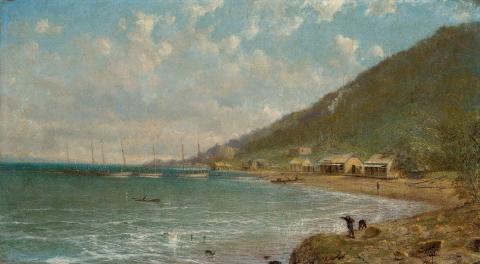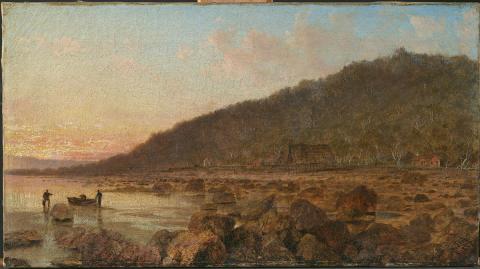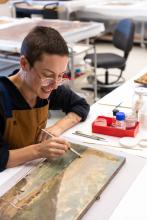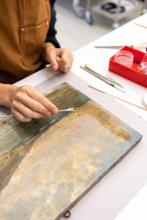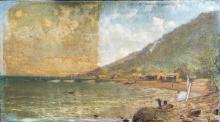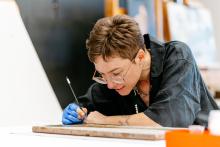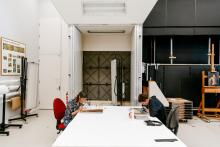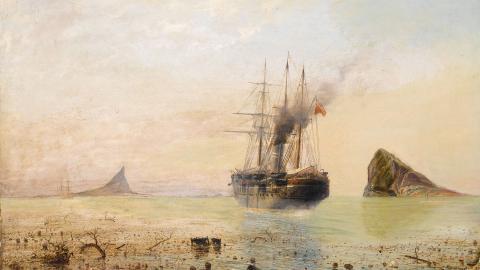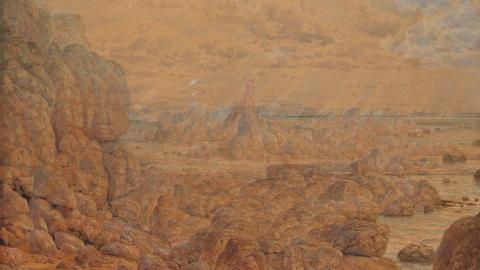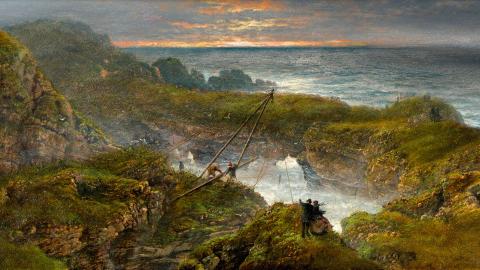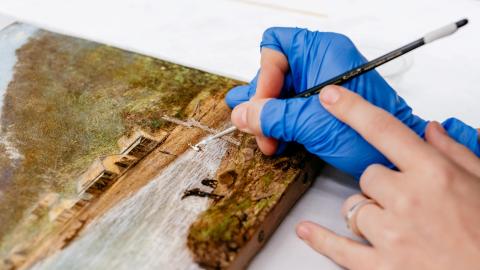Revealing Jenner’s blue skies
‘Isaac Walter Jenner: A Feeling for Light’
By Ruby Awburn
September 2023
Two oil paintings by Isaac Walter Jenner were gifted to QAGOMA by Geoffrey and Lorelle St Clair in 2020, and both needed significant interventive structural and cosmetic conservation treatment. Ruby Awburn, then Assistant Conservator (Paintings) at QAGOMA, describes the months of careful work required to restore one of these important works.

Assistant Conservator (Paintings), Ruby Awburn, with Isaac Walter Jenner’s Kelly & Cussen’s… 1897 at QAG, October 2022 / Photograph: J Ruckli, QAGOMA
A rare document
Kelly & Cussen’s Pearl Shelling Station on Prince of Wales Island, Torres Straits Queensland 1897 was acquired in 2020 with damage to the canvas — including a gaping tear — and a very discoloured, aged varnish layer disfiguring the composition. The history of the depicted station, Kelly & Cussen’s, is difficult to source; the colonisation of the Torres Strait Islands is not a subject commonly painted by early settlers. Muralag, colonised as Prince of Wales Island, had developed a small settlement by the late 1800s, mainly dedicated to the pearl shelling station. Pearl shells were marketable commodities used in the manufacture of buttons and decorative ornamentation.
The industry was fraught with abuses: South Sea Islanders, Aboriginal peoples and Torres Strait Islander peoples were commonly employed and paid up to £1 a month for the dangerous activity of diving. The early trade peaked in 1897, before the islands were over-fished and a series of natural disasters wiped out several lugger fleets. Jenner’s depiction of Muralag (Prince of Wales Island) at the turn of the century is thus a rare document.
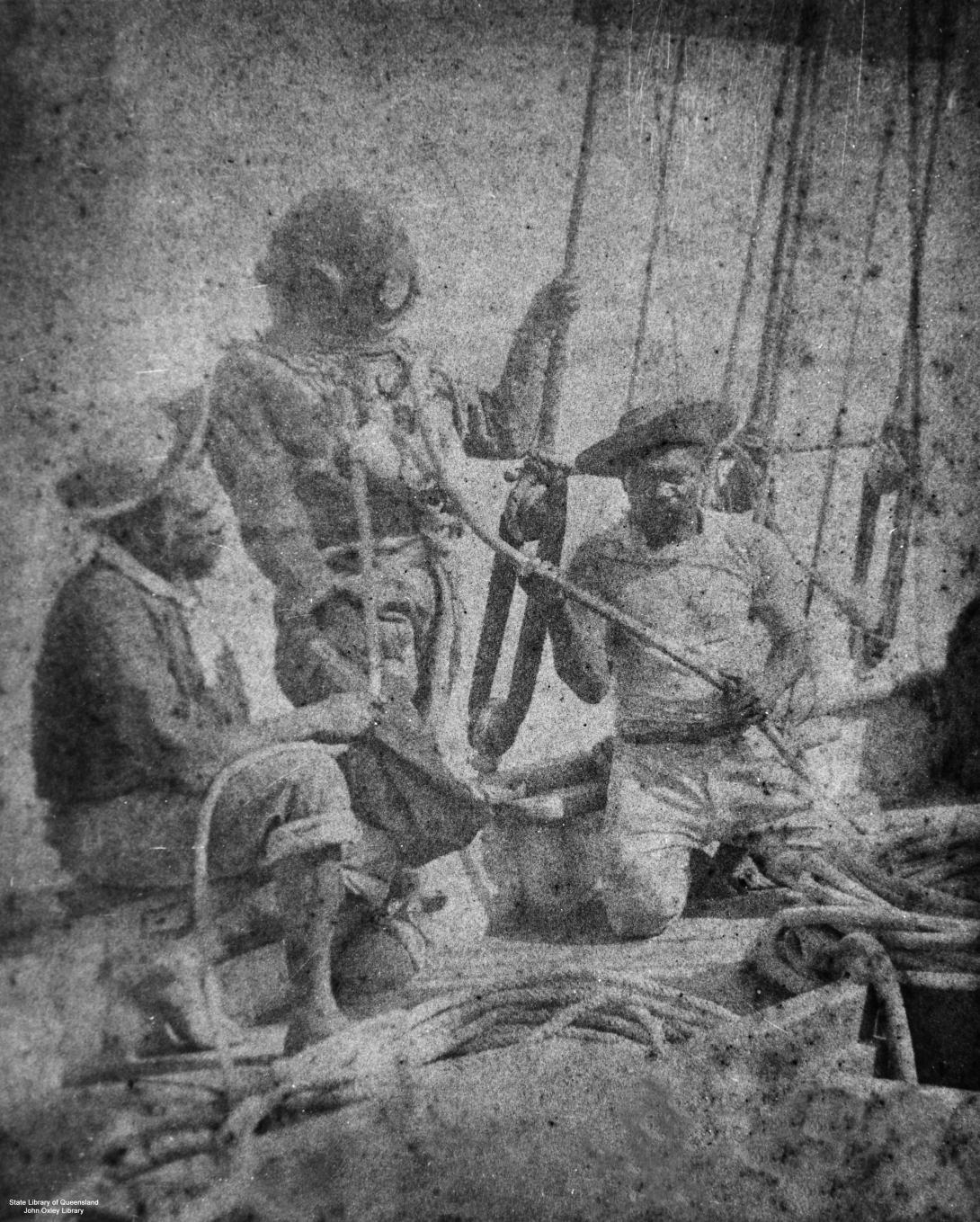
Pearl divers in the Torres Strait, Queensland, c.1895 / Image courtesy: John Oxley Library, State Library of Queensland
Stylistically, Jenner’s land and seascapes are imbued with romance. Frequently depicting dawn and sunset, Jenner’s compositions often capture a distinct moment in the day. Unfortunately, the degraded varnish of Kelly & Cussen’s… made the time of day ambiguous. The large tear in the canvas compromised the structural integrity of the painting, with further canvas distortions disrupting the surface plane.

Kelly & Cussen’s… 1897 before treatment, its degraded varnish casting a yellowed veil over the composition; a large tear in the canvas can be seen in the lower-right corner, January 2022 / Photograph: N Harth, QAGOMA
Analysis: Illuminating layers
Before the painting was treated, QAGOMA’s conservation team undertook technical examination and analysis to understand Jenner’s technique and materials. Paint analysis involved Fourier-transform infrared spectroscopy (FTIR) for initial characterisation, as well as ultraviolet (UV) fluorescence imaging, infrared reflectography (IRR) and cross-sections. Examining the painting in different wavelengths of the electromagnetic spectrum can provide clues to the process of making; for example, digital IRR allows us to view what is present beneath the painted surface. Various materials absorb and reflect infrared radiation differently to visible light, and often IRR will illuminate an artist’s underdrawing.
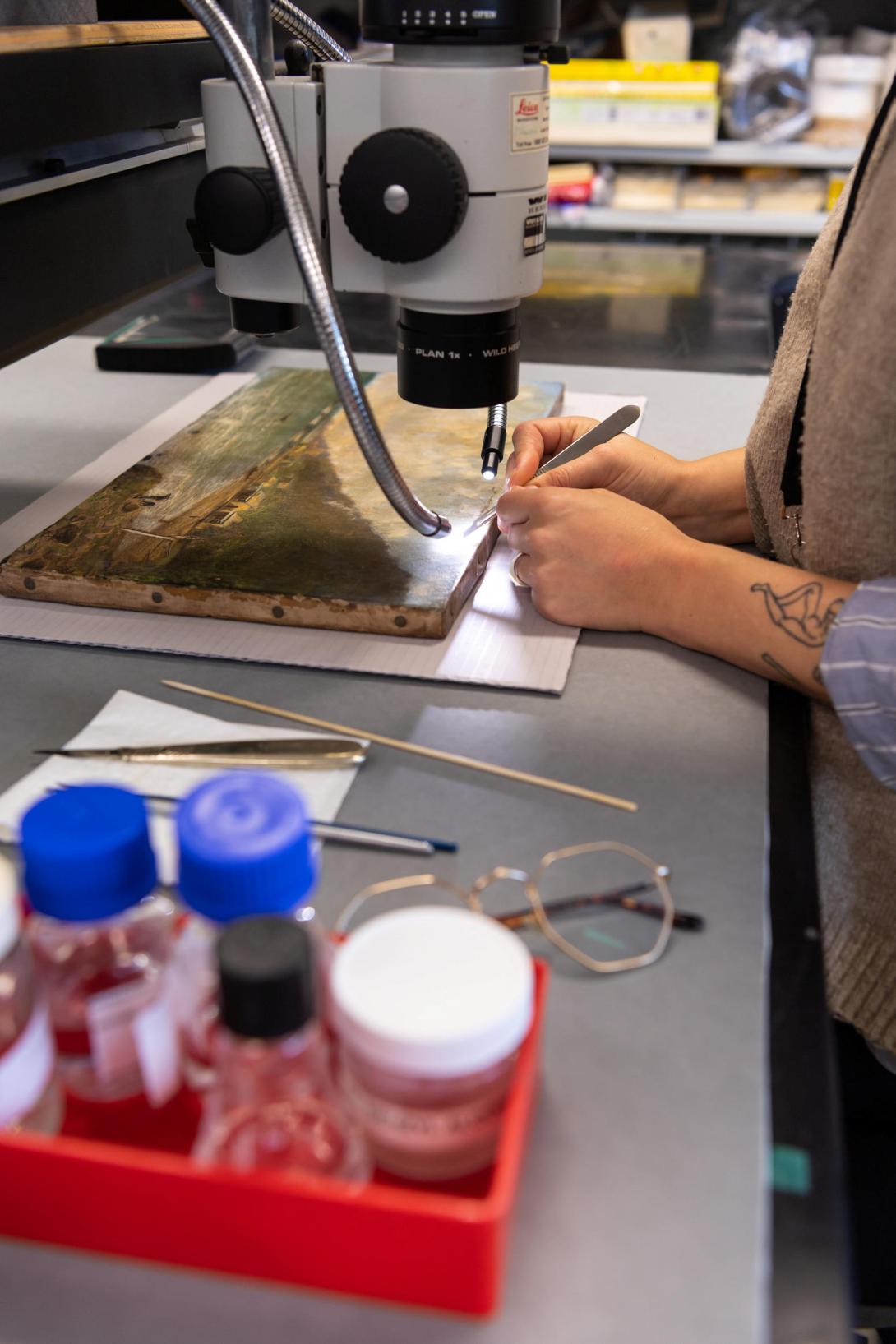
Awburn works on the painting’s surface using a stereo microscope, taking paint samples with a scalpel, November 2022 / Photograph: L Wilkes, QAGOMA
Jenner drafted intricate underdrawings before applying paint, and this work is no exception. Despite rigorous planning, the composition evolved as Jenner painted: there are figures on the beach with a boat that do not match the final composition; and the foreground figures are absent from the underlying drawing, as is the lone figure in the rowboat on the water. This allows us to deduce that Jenner developed this composition as he painted, probably from a preliminary sketch.
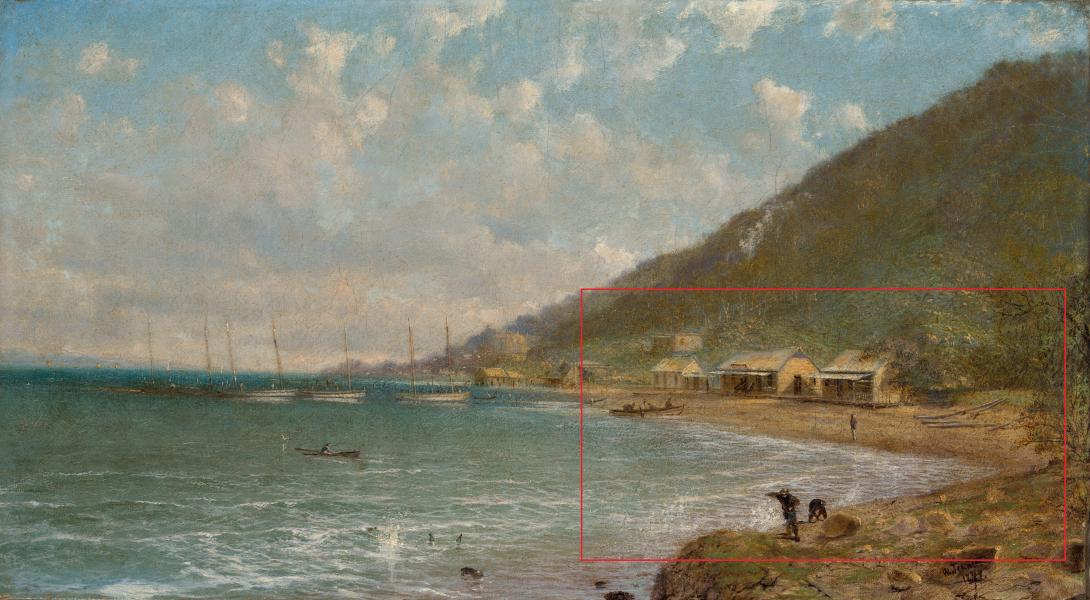
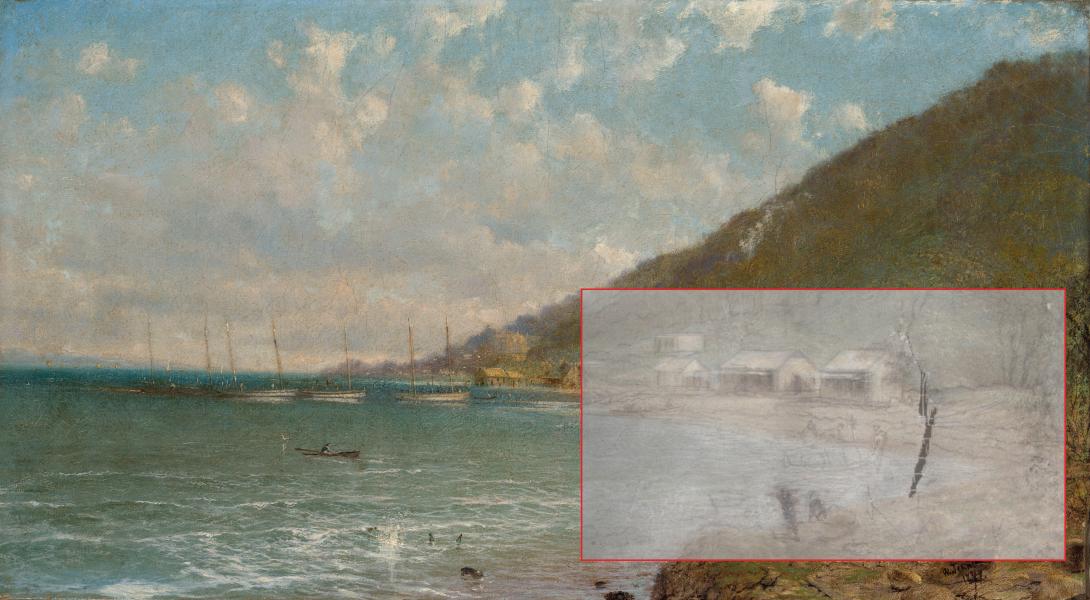
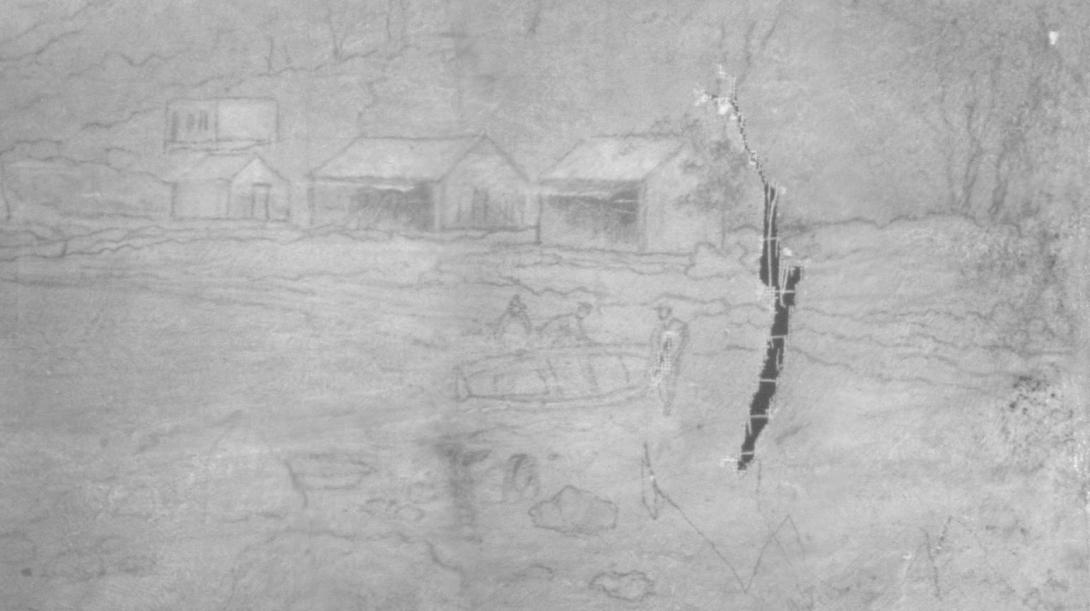

Infrared reflectography (IRR) reveals figures on the beach that Jenner did not retain in the final composition, as seen in this detail view / Images: QAGOMA
UV illumination induces fluorescence of the surface coating of the painting. In the case of Kelly & Cussen’s…, the strong green fluorescence indicated a natural resin varnish, such as dammar or mastic. The presence of natural resin was confirmed with FTIR analysis. Varnish layers have traditionally been used by artists to saturate pigments and provide a protective coating for their paintings. Though varnish is generally clear when first applied, radiation from sunlight and oxidation from contact with the air cause the material to degrade and turn yellow over time. This can distort the original colours intended by the artist — for example, blue may appear green. Looking at cross-sections of paint samples taken from the work also demonstrates the use of varnish, as well as thin layers of glazing. Understanding the strata of paint layers is important for treatment considerations, as layers of transparent glazing can further complicate the removal of varnish.

Cross-section sample from Kelly & Cussen's… 1897 depicting the layers of paint used by Jenner to create the sea in the image / Photograph: G Osmond, QAGOMA
Treatment: Thread by thread
When treating a painting, conservators first address structural issues to ensure the artwork is stable for further intervention. In regard to Kelly & Cussen’s…, this meant consolidating the flaking paint with a conservation adhesive to prevent further paint loss. Once the original paint layers were secure, distortions in the canvas were locally humidified and flattened. The painting was then surface cleaned with a customised aqueous solution to remove the thick layer of surface dirt and grime.
Gallery view: Awburn cleans the surface of Kelly & Cussen’s…, removing decades of dirt and layers of discoloured varnish, October 2022 / Photographs: L Wilkes, QAGOMA
A patch for the hole in the canvas was made using two different weights of Japanese tissue paper, adhered to the back of the canvas with a mixture of starch paste and an ethylene vinyl acetate (EVA) co-polymer adhesive. A canvas insert was subsequently made from a linen with the same thread count as the original, cut to the shape of the hole. This was adhered thread-by-thread to the original canvas threads under the microscope, which was further supported by the Japanese tissue patch.
Using a customised solvent gel made in the painting conservation lab, the aged varnish was carefully removed without disturbing the thin layers of glazing underneath, revealing a bright blue sky and jewel-toned water. The areas of paint losses, exposing the canvas and ground, were filled and in-painted using conservation-grade materials to cosmetically reintegrate the composition. A new varnish was applied, providing the saturated finish Jenner intended.
Gallery view: Kelly & Cussen’s… 1897 partway through cleaning; Awburn filling in tears in the canvas; and Gillian Osmond (Conservator, Paintings) cleaning Jenner’s O'Hagan & McAlister’s… 1897 across the table in the conservation studio at QAGOMA, January 2023 / Photographs: L Wilkes and J Ruckli, QAGOMA

Awburn fills a smaller tear in the canvas, to replicate the surface level and texture of Kelly & Cussen’s… 1897, QAG, January 2023 / Photograph: J Ruckli, QAGOMA
The big reveal: Before and after


Kelly & Cussen’s… photographed before conservation treatment in October 2022, compared to the finished work, six months later, in January 2023 / Photographs: N Harth, QAGOMA
Overall, the treatment of Kelly & Cussen’s Pearl Shelling Station took six months, achieved in moments between QAGOMA’s busy exhibition schedule. Jenner’s brushstrokes and fine details are no longer obscured by the thick, degraded varnish and damaged canvas. Now, its appearance complements the other works of art by Jenner within the Collection, including its partner painting O’Hagan & McAlister’s Pearl Shelling Station, Friday Island, Torres Straits Queensland 1897, gifted by the same lenders and similarly treated for exhibition in ‘Isaac Walter Jenner: A Feeling for Light’.


O’Hagan & McAlister’s… before conservation treatment in October 2022, compared to the finished work, photographed in July 2023 / Photographs: N Harth and K Travis, QAGOMA
Ruby Awburn, now based in New York, is former Assistant Conservator (Paintings) at QAGOMA.
Explore ‘A Feeling For Light’

Digital Story Introduction
ISAAC WALTER JENNERIsaac Walter Jenner: Curating a feeling for light
Read ESSAYDigital story context and navigation
ISAAC WALTER JENNERExplore the story

Digital Story Introduction
ISAAC WALTER JENNERIsaac Walter Jenner: Curating a feeling for light
Read ESSAYRelated resources
